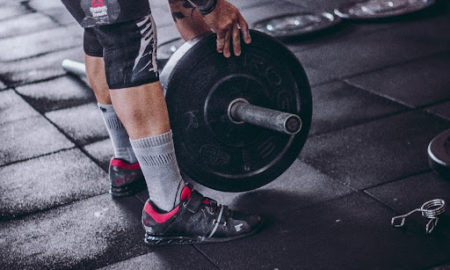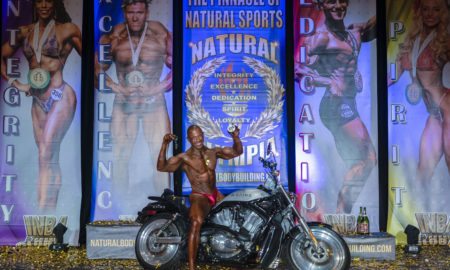Boxing legend George Foreman was unique in the sport in that he would stand between rounds. Some may consider that counterintuitive—if the goal is to recover between rounds, why would George expend more energy by staying on his feet?
His method is known scientifically as “active recovery” and involves performing light physical activity between sets or workouts. It’s the opposite of “passive recovery,” which involves relaxation, such as sitting down in a chair.
Both techniques are meant to improve performance and recovery. Evidence indicates, however, that active recovery between rounds may have given George an edge over his opponents. Active recovery can work for bodybuilders as well, at three distinct times: between sets, postworkout and between workouts.
Active Recovery Between Sets
The classic “burn” you feel between sets is caused by an accumulation of lactic acid, a by-product of anaerobic metabolism, which results in a decrease in weightlifting performance and, finally, an end to it. Decreasing pH reduces the activity of enzymes, lowers white blood cell count and nutrient transporters, and slows muscular contraction and ATP production.
It follows that in order to optimize performance, the goal should be to maximize lactic acid clearance. The most effective way to do that is through aerobic metabolism, providing ample oxygen to the muscles so they can clear lactic acid from the blood.
Studies indicate that the most effective way to accomplish that is with low intensity exercise—30 to 40 percent of your VO2 max.1,2 Exceeding that intensity risks crossing your lactate threshold and actually producing more lactic acid; lower intensity will minimize oxygen delivery to the muscles. So if you feel a deep burn in your muscles during active recovery, you likely need to lower your intensity.
The effectiveness of active recovery over passive recovery between sets has been demonstrated in sprinters and weightlifters, among other athletes. An excellent example was an experiment reported in the Journal of Strength and Conditioning Research. Fifteen experienced resistance-trained males performed weight workouts consisting of six sets of parallel squats at 85 percent of their 10-repetition maximum. The participants recovered for four minutes between sets with either passive sitting or low-intensity exercise on a stationary bicycle. After that workout participants performed a maximal-repetition squat test using 65 percent of their 10-rep maximum. The athletes engaging in active recovery were able to do 20 percent more repetitions than athletes who engaged in passive recovery between sets. No wonder George was able to smash all his opponents.
The typical bodybuilding workout involves taking short rest periods—less than one minute between sets. For variation, however, many bodybuilders implement a “heavy” day in their split or focus on progressive resistance with a few key lifts, such as squats. During those days maximal loads are lifted—greater than 85 percent one-rep maximum—and longer rest periods are taken, usually three to five minutes between sets. On heavy training days, when the primary goal is to increase your strength, active recovery will prove most helpful.
Optimally, you perform active recovery specific to the muscle group trained. For example, if you’re training legs, you might walk around between sets or use a stationary bike. If you’re training delts, you might use the elliptical, or lightly shake your arms around between sets.
Active Recovery Postworkout
The goal of postexercise active recovery—commonly known as the cooldown—is similar to active recovery between sets: lactic acid removal. The half-life of lactic acid is normally 15 to 25 minutes after physical activity; however, lactic acid may return immediately to baseline after a single cooldown session. That’s important, as a cooldown performed immediately after exercise can reduce the decline in white blood cell count by a whopping 30 percent, effectively promoting a healthy immune system. That’s particularly applicable to the bodybuilder whose high-volume workouts may impair immune function in the hours following training. Lastly, active recovery can be very useful for bodybuilders training twice daily, so they recover faster for their second session.
For optimal postworkout recovery you need to exercise 10 to 15 minutes at 30 to 40 percent of your VO2 max. Examples include a light walk, slow cycle or moderate pace on the elliptical. Again, try to target the muscle group you previously trained.
Active Recovery Between Workouts
On the day following your workout, lactic acid will be long gone. A new problem called delayed-onset muscle soreness will arrive, however. The goal of performing active recovery between workouts is to relieve that pain and improve recovery so you can train again sooner—and harder.
You want to do enough exercise to increase blood and nutrient delivery to the muscles but not so much as to increase muscle damage. Studies are clear that cellular hydration via a “pump” is an effective way to enhance protein synthesis and lower protein degradation.
The effectiveness of active recovery between workouts has been demonstrated in a number of studies. In one study eight subjects rested after a taxing biceps workout, while nine others performed a lighter training session to aid recovery. Researchers found that strength recovery was greater after light exercise than after rest alone.
There’s no set recommendation for active recovery between workouts. Generally we would recommend higher reps—10 to 15—and nonfailure lifting for three to six sets, with a rest of less than one minute between sets. Most muscle damage occurs on the eccentric, or lowering, portion of the lift. So you could have a training partner take the weight on the eccentric while you lift on the raising, or concentric, phase.
A potentially effective method of active recovery between workouts that has not yet been tested is blood occlusion training; Layne Norton wrote about it in the April ’08 IRON MAN. Blood occlusion training involves wrapping a device, such as a knee wrap, around the proximal portion of a limb and then performing exercises with that limb. The technique effectively enhances blood flow, protein synthesis and growth hormone while not increasing muscle damage. So it seems to be a fine candidate for active recovery between workouts.
Be sure to have ample nutrients before and after exercise to maximize recovery.
You must have known all along that little good ever comes from just sitting down on a bench and collapsing. As you now know, when you feel the burn between sets, move; when you feel it after your workouts, move; and when you feel sore the next day—you guessed it—move some more.
Editor’s note: Gabriel Wilson is completing his Ph.D. in nutrition with an emphasis on optimal protein requirements for muscle growth and is a researcher in the Division of Nutritional Sciences, University of Illinois, Urbana. He is vice president of the Web site ABCBodybuilding.com. Jacob Wilson is a skeletal-muscle physiologist and researcher in the Department of Nutrition, Food, and Exercise Science, Florida State University, Tallahassee. He is president of the Web site ABCBodybuilding.com.
References
1 Hultman, E., and Sahlin, K. (1980). Acid-base balance during exercise. Exerc Sport Sci Rev. 8:41-128.
2 Hogan, M.C., et al. (1995). Increased [lactate] in working dog muscle reduces tension development independent of pH. Med Sci Sports Exerc. 27(3):371-377. IM
















You must be logged in to post a comment Login